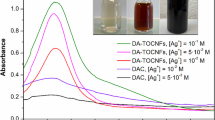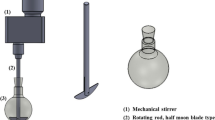Abstract
Cellulose Nanofibrils (CNFs) were exposed to a certain amount of sodium chloride (NaCl) before being subjected to two types of drying methods (freeze drying and vacuum drying). The effect of two drying methods on water redispersibility of CNFs was investigated by characterizing product morphology, particle size distribution, water stability, and surface chemistry. The results showed that vacuum drying was favorable for the redispersion of CNFs with NaCl resulted in more homogenous fibril structure with lower mean particle sizes and higher water stability. Fourier transform-infrared spectroscopy (FT-IR) and Energy-dispersive X-ray Spectroscopy (EDX) experiments indicated that vacuum drying at pH 8 was more conducive to complexation between Na+ and carboxyl, hydroxyl groups favorable for CNF redispersion. Furthermore, NaCl is cheap, and the process is very straightforward which does not require any organic solvents or hazardous chemicals. Therefore, vacuum drying with NaCl may be considered as a green and economically feasible method for preparation of water redispersible dried CNFs.
Graphic abstract









Similar content being viewed by others
References
Barkoula NM, Alcock B, Cabrera NO, Peijs T (2008) Flame-retardancy properties of intumescent ammonium poly(phosphate) and mineral filler magnesium hydroxide in combination with graphene. Polym Polym Compos 16:101–113
Beaumont M, König J, Opietnik M et al (2017) Drying of a cellulose II gel: effect of physical modification and redispersibility in water. Cellulose 24:1199–1209. https://doi.org/10.1007/s10570-016-1166-9
Beck S, Bouchard J, Berry R (2012) Dispersibility in water of dried nanocrystalline cellulose. Biomacromolecules 13:1486–1494. https://doi.org/10.1021/bm300191k
Brodin FW, Theliander H (2013) A comparison of softwood and birch kraft pulp fibers as raw materials for production of TEMPO-oxidized pulp, MFC and superabsorbent foam. Cellulose 20:2825–2838. https://doi.org/10.1007/s10570-013-0037-x
Butchosa N, Zhou Q (2014) Water redispersible cellulose nanofibrils adsorbed with carboxymethyl cellulose. Cellulose 21:4349–4358. https://doi.org/10.1007/s10570-014-0452-7
Dong XM, Gray DG (1997) Effect of counterions on ordered phase formation in suspensions of charged rodlike cellulose crystallites. Langmuir 13:2404–2409. https://doi.org/10.1021/la960724h
Dzyaloshinskii IE, Lifshitz EM, Pitaevskii LP (1961) General theory of Van Der Waals’ forces. Sov Phys Uspekhi 4:153–176. https://doi.org/10.1070/pu1961v004n02abeh003330
Eyholzer C, Bordeanu N, Lopez-Suevos F et al (2010) Preparation and characterization of water-redispersible nanofibrillated cellulose in powder form. Cellulose 17:19–30. https://doi.org/10.1007/s10570-009-9372-3
Fall AB, Lindström SB, Sundman O et al (2011) Colloidal stability of aqueous nanofibrillated cellulose dispersions. Langmuir 27:11332–11338. https://doi.org/10.1021/la201947x
Habibi Y, Lucia LA, Rojas OJ (2010) Cellulose nanocrystals: chemistry, self-assembly, and applications. Chem Rev 110:3479–3500. https://doi.org/10.1021/cr900339w
He M, Cho BU, Won JM (2016) Effect of precipitated calcium carbonate—cellulose nanofibrils composite filler on paper properties. Carbohydr Polym 136:820–825. https://doi.org/10.1016/j.carbpol.2015.09.069
He M, Yang G, Chen J et al (2018) Production and characterization of cellulose nanofibrils from different chemical and mechanical pulps. J Wood Chem Technol 38:149–158. https://doi.org/10.1080/02773813.2017.1411368
Ho TTT, Zimmermann T, Hauert R, Caseri W (2011) Preparation and characterization of cationic nanofibrillated cellulose from etherification and high-shear disintegration processes. Cellulose 18:1391–1406. https://doi.org/10.1007/s10570-011-9591-2
Im W, Lee S, Rajabi Abhari A et al (2018) Optimization of carboxymethylation reaction as a pretreatment for production of cellulose nanofibrils. Cellulose 25:3873–3883. https://doi.org/10.1007/s10570-018-1853-9
Kedar KA, Chaudhari SR, Rao AS (2018) Dataset on leaf surface and elemental study of four species of Bignoniaceae family by SEM-EDAX. Data Brief 17:1188–1195. https://doi.org/10.1016/j.dib.2018.02.037
Li D, Li L, Xiao N et al (2018) Physical properties of oil-in-water nanoemulsions stabilized by OSA-modified starch for the encapsulation of lycopene. Colloids Surfaces A Physicochem Eng Asp 552:59–66. https://doi.org/10.1016/j.colsurfa.2018.04.055
Missoum K, Bras J, Belgacem MN (2012) Water redispersible dried nanofibrillated cellulose by adding sodium chloride. Biomacromolecules 13:4118–4125. https://doi.org/10.1021/bm301378n
Moon RJ, Martini A, Nairn J et al (2011) Cellulose nanomaterials review: structure, properties and nanocomposites. Chem Soc Rev 40(7):3941–3994
Newman RH (2004) Carbon-13 NMR evidence for cocrystallization of cellulose as a mechanism for hornification of bleached kraft pulp. Cellulose 11:45–52. https://doi.org/10.1023/B:CELL.0000014768.28924.0c
Olszewska A, Eronen P, Johansson LS et al (2011) The behaviour of cationic nanofibrillar cellulose in aqueous media. Cellulose 18:1213–1226. https://doi.org/10.1007/s10570-011-9577-0
Peng Y, Gardner DJ, Han Y (2012) Drying cellulose nanofibrils: in search of a suitable method. Cellulose 19:91–102. https://doi.org/10.1007/s10570-011-9630-z
Peng Y, Gardner DJ, Han Y et al (2013) Influence of drying method on the material properties of nanocellulose I: thermostability and crystallinity. Cellulose 20:2379–2392. https://doi.org/10.1007/s10570-013-0019-z
Peralta-Inga Z, Johnson GP, Dowd MK et al (2002) The crystal structure of the α-cellobiose·2 NaI·2 H2O complex in the context of related structures and conformational analysis. Carbohydr Res 337:852–861. https://doi.org/10.1016/s0008-6215(02)00041-1
Proniewicz LM, Paluszkiewicz C, Wesełucha-Birczyńska A et al (2001) FT-IR and FT-Raman study of hydrothermally degradated cellulose. J Mol Struct 596:163–169. https://doi.org/10.1016/S0022-2860(01)00706-2
Qiu J, Zhang H, Liang C et al (2006) Co/CNF catalysts tailored by controlling the deposition of metal colloids onto CNFs: preparation and catalytic properties. Chem Eur J 12:2147–2151. https://doi.org/10.1002/chem.200500960
Sim K, Lee J, Lee H, Youn HJ (2015) Flocculation behavior of cellulose nanofibrils under different salt conditions and its impact on network strength and dewatering ability. Cellulose 22:3689–3700. https://doi.org/10.1007/s10570-015-0784-y
Siqueira G, Bras J, Dufresne A (2010) New process of chemical grafting of cellulose nanoparticles with a long chain isocyanate. Langmuir 26:402–411. https://doi.org/10.1021/la9028595
Turbak AF, Snyder FW, Sandberg KR (1983) Microfibrillated cellulose, a new cellulose product: properties, uses, and commercial potential. J Appl Polym Sci 37:815–827
Van Oss CJ, Good RJ, Chaudhury MK (1986) The role of van der Waals forces and hydrogen bonds in “hydrophobic interactions” between biopolymers and low energy surfaces. J Colloid Interface Sci 111:378–390. https://doi.org/10.1016/0021-9797(86)90041-X
Velásquez-Cock J, Gañán P, Gómez HC et al (2018) Improved redispersibility of cellulose nanofibrils in water using maltodextrin as a green, easily removable and non-toxic additive. Food Hydrocoll 79:30–39. https://doi.org/10.1016/j.foodhyd.2017.12.024
Verwey EJW (1947) Theory of the stability of lyophobic colloids. J Phys Chem B 51(3):631–636
Vuoti S, Talja R, Johansson LS et al (2013) Solvent impact on esterification and film formation ability of nanofibrillated cellulose. Cellulose 20:2359–2370. https://doi.org/10.1007/s10570-013-9983-6
Wågberg L, Decher G, Norgren M, Lindström T, Ankerfors M, Axnäs K (2008) The build-up of polyelectrolyte multilayers of microfibrillated cellulose and cationic polyelectrolytes. Langmuir 24:784–795
Wiśniewska M (2010) Influences of polyacrylic acid adsorption and temperature on the alumina suspension stability. Powder Technol 198:258–266. https://doi.org/10.1016/j.powtec.2009.11.016
Xhanari K, Syverud K, Chinga-Carrasco G et al (2011) Reduction of water wettability of nanofibrillated cellulose by adsorption of cationic surfactants. Cellulose 18:257–270. https://doi.org/10.1007/s10570-010-9482-y
Zhang J, Hu YS, Tessonnier JP et al (2008) CNFs@CNTs: superior carbon for electrochemical energy storage. Adv Mater 20:1450–1455. https://doi.org/10.1002/adma.200701685
Zhang P, Shao C, Zhang Z et al (2011) In situ assembly of well-dispersed Ag nanoparticles (AgNPs) on electrospun carbon nanofibers (CNFs) for catalytic reduction of 4-nitrophenol. Nanoscale 3:3357–3363. https://doi.org/10.1039/c1nr10405e
Zhang Z, Tingaut P, Rentsch D et al (2015) Controlled silylation of nanofibrillated cellulose in water: reinforcement of a model polydimethylsiloxane network. ChemSusChem 8:2681–2690. https://doi.org/10.1002/cssc.201500525
Acknowledgments
The authors are deeply grateful for the financial support received from the National Natural Science Foundation of China (Grant nos. 31770628, 31901267), the Taishan Scholars Program, a project (Grant no. ZR2019BC042) supported by Shandong Provincial Natural Science Foundation, and a Project of Shandong Province Higher Educational Science and Technology Program (Grant no. J18KA111) and the Program of State Key Laboratory of Pulp and Paper Engineering (Grant no. 201815), the Provincial Key Research and Development Program of Shandong (Grant nos. 2019JZZY010326, 2019JZZY010328).
Author information
Authors and Affiliations
Contributions
Guangrui Ma and Ming He have contributed equally to this work. All authors have given approval to the final version of the manuscript.
Corresponding authors
Ethics declarations
Conflict of interest
The authors declare that they have no known competing financial interests or personal relationships that could have appeared to influence the work reported in this paper.
Additional information
Publisher’s Note
Springer Nature remains neutral with regard to jurisdictional claims in published maps and institutional affiliations.
Supplementary material
Rights and permissions
About this article
Cite this article
Ma, G., He, M., Yang, G. et al. A feasible approach efficiently redisperse dried cellulose nanofibrils in water: vacuum or freeze drying in the presence of sodium chloride. Cellulose 28, 829–842 (2021). https://doi.org/10.1007/s10570-020-03591-y
Received:
Accepted:
Published:
Issue Date:
DOI: https://doi.org/10.1007/s10570-020-03591-y




